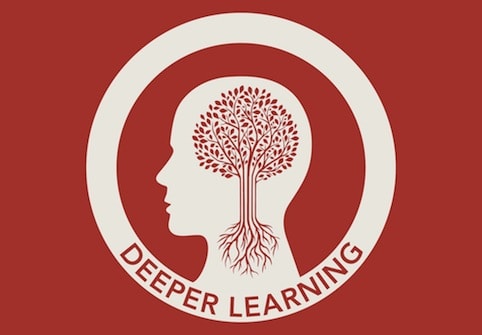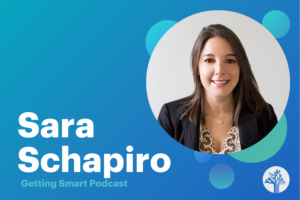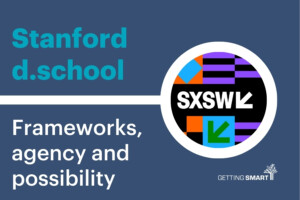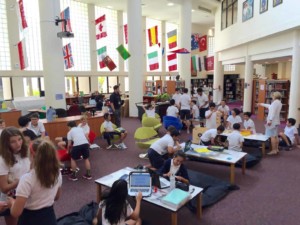Leading for Deeper Learning: 10 Proven Strategies

Over the summer we interviewed two dozen school and network leaders producing strong academic results and developing powerful young people. Considering their leadership stories, we found ten things in common:
-
Good goals. Good schools have good goals; they use a variety of strategies to personalize learning supported by aligned supports, staffing, and schedule. Danville Kentucky is great example with goals focused on powerful learning experience, growth, global preparedness, communication, and community. Deeper learning will be a random occurrence without goals that make it a priority.
-
Equity focus. Schools that promote deeper learning engage all students–not just honor students–in powerful learning experiences; they develop academic mindsets scaffolded by strong supports. According to principal Stephen Mahoney, “The accomplishments of Springfield Renaissance School’s students prove that a child’s zip code does not determine his or her destiny.”
-
Powerful designs. Most striking about these interviews was school leader efforts to create coherence: purposeful goals, intentional culture, powerful learning, with aligned structures, staffing, schedules, and supportive technology. That’s not easy. It’s always a dynamic process, especially for leaders inheriting a school rather than designing from scratch.
-
Teacher support. The districts and networks we studied support teachers. They make it increasingly possible for all of their teachers to achieve great results with common frameworks, big goals and good plans, learning platforms, and strong development systems for adult learners.
-
Show what you know. The schools we studied are competency-based. In different ways, they ask students to show what they know and make public presentations of learning. Students progress based on demonstrated mastery. (CompetencyWorks from iNACOL is a great resource and online community.)
-
Strong culture. All of the schools we studied had a powerful intentional culture. “We’re a values first organization,” said Bill Kurtz, CEO of DSST Public Schools, an example of a network with a strong culture where students receive regular feedback on attributes of character development. “Each human being strives to be fully known and affirmed for who they are and to contribute something significant to the human story,” said Kurtz.
-
Good habits. Good schools build good habits. Many of the school we studied use Debbie Meier’s Habits of Mind: significance, perspective, evidence, connection, and supposition. Some, like Springfield Renaissance, complement these with habits of work: ready to learn, active participation, assess and revise, contribute to group work, complete homework.
-
Sense of place. Good schools not only leverage community assets, but they take kids on learning trips. A group of students from Casco Bay High School, Portland Maine, visited coal mining towns in Appalachia last year. Students from Minnesota New Country visited the Mississippi delta and came back passionate about civil rights.
-
Projects. Every school we interviewed made good use of project-based learning. Project goals often leveraged student interest, always incorporated standards-based assessment, and periodically resulted in public demonstrations.
-
Great questions. “We want people to be perplexed—to embrace the paradox of starting new schools,” said High Tech High founder Larry Rosenstock. Great schools, like DSST, incorporate this “perplexity” into the curriculum. Ninth graders take Creative Engineering, which, according to teacher Jim Stephens, “requires empathy, ideation, and prototyping before they can arrive at a solution—they learn that they can solve any problem, in or out of school, with this approach. They also take Big History, a course that “covers the history of the universe, the planet, and human history.”
The majority of schools we studied were purpose built and more than half belong to school development networks committed to deeper learning–two big advantages for leaders seeking to consistently challenge and engage students in meaningful work. For leaders working in existing schools that were not purpose built, there is still an opportunity for them to be purpose led.
Schoolwide adoption of deeper learning strategies and practices takes leadership–consider the ten categories above. The profiled schools have an unusually high number of schoolwide agreements. These are not schools where teachers are freelancing; they may have autonomies but they work together within a shared frame with common strategies and practices.
Add the rapidly increasing array of blended tools and strategies, and the number of schoolwide agreements doubles. As we noted in the Blended Learning Implementation Guide, big leadership decisions include goals, school model, platform and content, devices, staffing and staff development.
Leadership levers. New Leaders created the Urban Excellence Framework to identify key levers for change. The primary drivers (shown in the exhibit below) are culture, and learning and teaching. The last five common elements we found fall in this category. Supporting levers include aligned staff, operations and systems–the first five foundational elements in the list above.
Good schools have more schoolwide agreements than schools on autopilot–that’s particularly true for schools promoting deeper learning because they use sophisticated rather than scripted instructional strategies.
Incorporating blended learning strategies may double the number of schoolwide agreements–it mucks around with all of the operations and systems. This is compounded by the fact that the opportunity set is evolving and dynamic suggesting that these agreements must be frequently reconsidered.
The most important implication of this dynamic opportunity set is that school leaders need to be conversation leaders and agreement makers. They need to help their school communities become aware of the needs for high standards, strategic options, and emerging opportunities. They need to craft temporary agreements that allow the school to move forward with the expectation that agreements will be reconsidered as opportunities and challenges warrant.
Agreement crafting is tough enough when we’re talking about instructional strategies (e.g., projects versus direction instruction) but when you start mucking around with the operations and systems (e.g., standards based grading and competency-based progressions) it gets everybody’s attention.
Conversation leaders facilitate field trip leaders–one way or another they transport people to the desired future state. That may be visiting an innovative school, reading and discussing NGLC profiles, or sharing a virtual field trip to Carpe Diem in Yuma. Katie Decker, principal of Braken STEAM Academy in Clark County, creates time during the day for teachers to take field trips to other classrooms in the school. The New Leaders report suggests that a principal’s personal leadership is foundational for a school’s success–an observation confirmed by Decker’s conversation leadership.







0 Comments
Leave a Comment
Your email address will not be published. All fields are required.